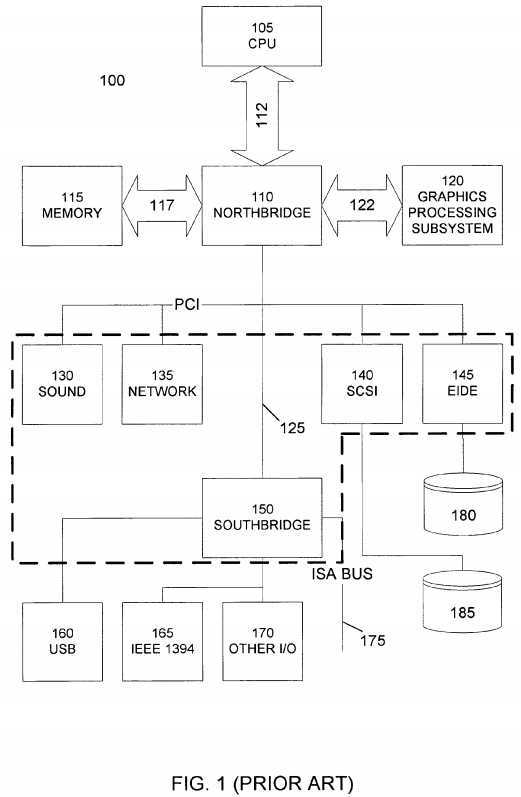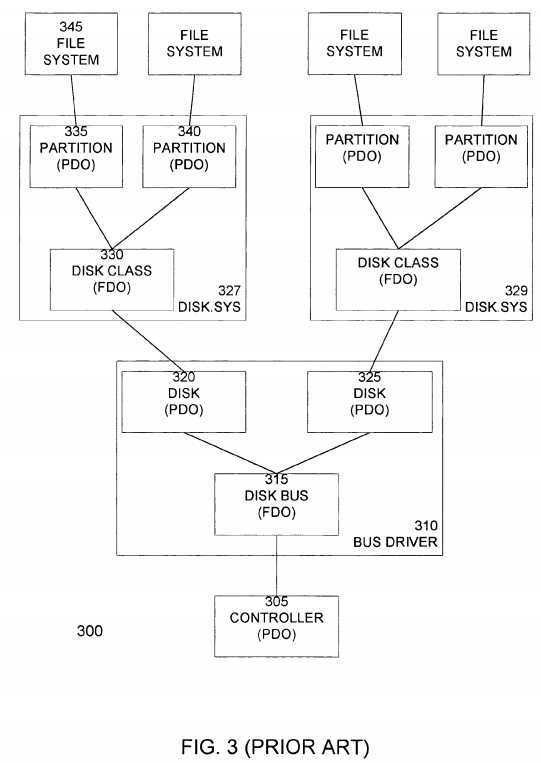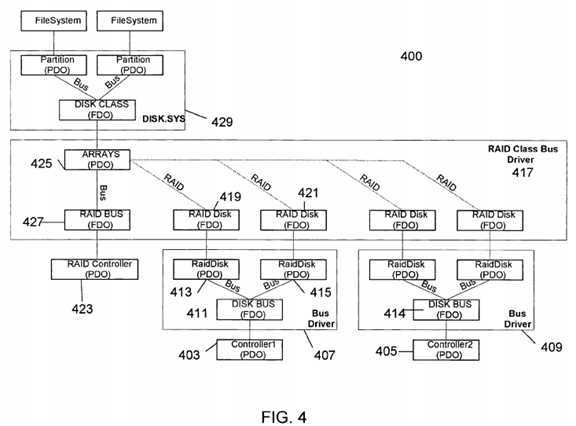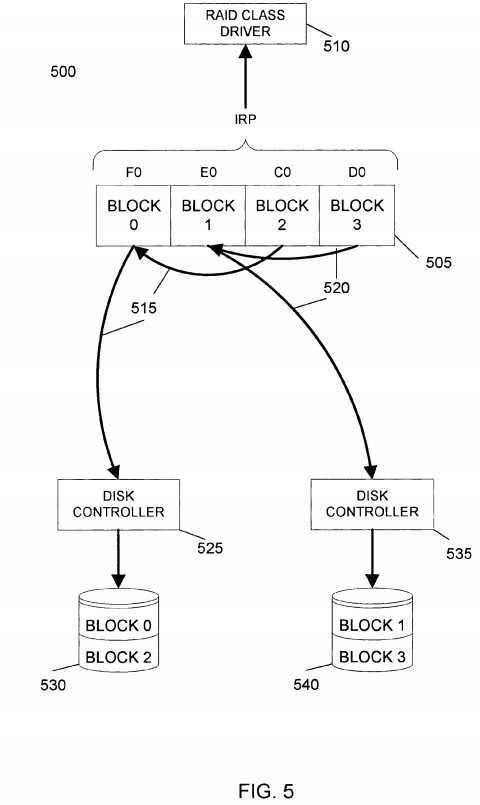标签:des style class blog http tar
The present invention relates to the field of data storage devices. Computers often store large quantities of data, including data such as music, video, games, applications, and other valuable information, on hard disk drives and other data storage devices, which are referred to herein generally as "disks". As users‘ storage needs increase and the price of disks fall, computers often employ multiple disks to meet their storage needs.
To improve performance, reliability, and efficiency in using multiple disks for data storage, two or more disks can be combined into a single "logical" disk. One common disk architecture for combining multiple disks is?RAID?(Redundant Array of Independent Disks). Although?RAID?systems can provide improved disk performance and/or reliability,?RAID?systems are complicated to set up and configure. Additionally,?RAID?systems typically require specialized disk controllers and driver software. Thus,?RAID?systems are typically too expensive and too difficult for use by most computer users.
Additionally, because some current?RAID?systems require specialized disk controllers, they are limited in the number and type of disks that can be combined. For example, it is virtually impossible for current?RAID?systems to combine an EIDE disk and a SCSI disk in the same?RAID?system. In other?RAID?systems, the computer operating systems combines disk partitions, rather than the underlying disk itself, to create the?RAID?system. Because disk partitions are defined by the operating system, the disk partitions, and hence the entire?RAID?system, are inaccessible until the operating system has loaded. Thus in these implementations, the computer cannot be booted from the?RAID?system.
It is therefore desirable for a system and method to enable users to easily combine two or more disks into a bootable?RAID?system without specialized disk controllers. It is further desirable to be able to create?RAID?systems using disks of different types, controllers, and interfaces.
The invention generally is a?RAID?class driver model that enables users to easily combine two or more disks into a bootable?RAID?system without specialized disk controllers and allows the creation of?RAID?systems using disks of different types, controllers, and interfaces. A?RAID?class driver is initialized in response to the identification of a?RAID?controller. Disk controllers return?RAID-specific device identifications, rather than standard disk device identifications, for each disk to be included in the?RAID?system. The?RAID?class driver binds a?RAID-specific functional interface to each disk having a?RAID-specific device identification and combines the disks into a disk object representing the entire?RAID?system. The disk object provides the operating system with a standard disk device identification. The operating system loads a standard disk driver to interface with the disk object, thereby enabling transparent access to the?RAID?system.
In an embodiment, a storage disk device driver architecture comprises a?RAID?class driver having a physical device object representing a?RAIDsystem. The?RAID?system includes a plurality of disks. Each disk is associated with a functional device object adapted to interface with a physical device object representing the disk. The physical device object representing each disk provides a?RAID-specific device identification. In a further embodiment, the physical device object that provides a?RAID-specific device identification is included in a disk controller driver adapted to interface with a disk controller. In still another embodiment, the physical device object representing the?RAID?system is adapted to provide a standard disk device identification to an operating system.
In an embodiment, the?RAID?class driver is adapted to combine each disk into a?RAID?system. In one aspect of this embodiment, in response to receiving a request to write a data block to?RAID?system, the?RAID?class driver is adapted to mirror the data block on at least a portion of the plurality of disks via the associated functional device objects. In another aspect of this embodiment, in response to receiving a request to write a first and second data block to?RAID?system, the?RAID?class driver is adapted to write via the associated functional device objects the first data block to a first portion of the plurality of disks and to write via the associated functional device objects the second data block to a second portion of the plurality of disks. In another aspect of this embodiment, in response to receiving a request to write a first and second data block to?RAID?system, the?RAID class driver is adapted to write via the associated functional device objects an error correction block to a portion of the plurality of disks.
In yet a further embodiment, a first portion of the plurality of disks is associated with a first disk controller of a first type and a second portion of the plurality of disks is associated with a second disk controller of a second type. In one aspect of this embodiment, the first type is an EIDE type controller and the second type is a SCSI type controller. In another aspect, the first type is a serial ATA type controller and the second type is a parallel ATA type controller. In a third aspect, the second type is a controller for an external disk.
FIG. 1 is a block diagram of a computer system?100, such as a personal computer, video game console, personal digital assistant, or other digital device, suitable for practicing an embodiment of the invention. Computer system?100?includes a central processing unit (CPU)?105?for running software applications and optionally an operating system. In an embodiment, CPU?105?is actually several separate central processing units operating in parallel.

CPU?105?is connected with Northbridge?110?via CPU bus?112. The Northbridge?110?passes data between the CPU?105?and the memory?115?via memory bus?117, and between CPU?105?and graphics processing subsystem?120?via graphics bus?122. Buses?112,?117, and?122?may be implemented as any type of data transport bus, including proprietary processor and memory buses, and AGP, PCI, PCI-X, and Hypertransport buses. In an alternate embodiment, CPU?105?includes a memory controller that interfaces with memory?115?directly, bypassing Northbridge?110.
The graphics subsystem?120?includes a graphics processing unit and optionally graphics memory for storing pixel data associated with output images. The graphics subsystem?120?periodically outputs pixel data for an image to a display device. Display device is any device capable of displaying visual information in response to a signal from the computer system?100, including CRT, LCD, plasma, and OLED displays. Computer system?100?can provide the display device with an analog or digital signal. In an alternate embodiment, the graphics processing subsystem is integrated with other computer system components, such the Northbridge?110.
Northbridge?110?is further interfaced with PCI bus?125. PCI bus?125?connects numerous peripheral devices with the computer system?100. Example peripheral devices include sound device?130, network interface?135, and disk controllers such as SCSI controller?140?and EIDE controller?145. Network interface?135?enables computer system?100?to communicate with other computer systems via an electronic communications network, and may include wired or wireless communication over local area networks and wide area networks such as the Internet.
The disk controllers enable access to non-volatile storage devices for applications and data and may include fixed disk drives, removable disk drives, flash memory devices, and CD-ROM, DVD-ROM, or other optical storage devices. In computer system?100, SCSI controller?140?is connected with one or more SCSI disks?185, and EIDE controller?145?is connected with one or more EIDE drives?180. EIDE drives may include drives using a parallel ATA interface (PATA) or a serial ATA interface (SATA). In a further embodiment, additional disks can be connected through additional disk controllers, which are typically used for internal drives, through USB and IEEE 1394 interfaces, which are typically used for external drives, and through wired and wireless network interfaces.
Southbridge?150?is also connected with PCI bus?125. Together, the Northbridge and Southbridge provide core logic functions of the computer system. Southbridge?150?enables I/O interfaces for numerous input and output devices, such as keyboards, mice, joysticks, touchpads, digital still and video cameras, printers, scanners, and digital music devices. Southbridge?150?may support any number of I/O interfaces, such as USB 1.0 or 2.0 interface?160, IEEE 1394 interface?165, and other I/O interfaces?170, including serial, parallel, PS/2, and Bluetooth interfaces. Southbridge?150also may support legacy peripheral devices through ISA bus?175. In a further embodiment, some or all of the peripheral devices?155?can be integrated into Southbridge?150, including disk controllers?140?and?145, sound device?130, network interface?135, and I/O interfaces?160,?165, and170.
FIGS. 2A,?2B, and?2C illustrate example prior art?RAID?system implementations that may be created by an embodiment of the invention. As discussed above, a?RAID?system combines multiple disks into a single "logical" disk.?RAID?systems are typically divided into different categories or levels. There are numerous different levels, each of which includes some combination of mirroring, striping, and/or parity information. Each?RAID level offers a different degree of improved reliability and/or higher performance. Discussed below are three of the more common?RAID implementations; however, the invention is generally applicable to any combination of drives in any?RAID?implementation. 
FIG. 2A illustrates an example?RAID 1?implementation?200, also referred to as mirroring, that provides improved reliability. As data is written to?RAID system?200,?RAID?controller?205?writes the data in parallel to drives?210?and?215. In this?RAID?system, writing, or mirroring, data on drives?210?and 215?provides an automatic backup of data should one disk fail or become corrupted. In a further embodiment, a third disk?220?is connected with RAID?controller?205?as a "hot spare." In the event of a failure of disk?210?or?215,?RAID?controller?205?will activate disk?220?and copy over the contents of the remaining operable drive. Subsequent data writes will then be mirrored on disk?220, rather than the defective drive.
FIG. 2B illustrates an example?RAID 0?implementation?235, also referred to as striping, that provides improved disk read and write performance. RAID 0?implementation?235?divides data into blocks and distributes the blocks over two disks,?245?and?250.?RAID?controller?240?reads and writes data from both drives in parallel, effectively doubling disk performance for disk accesses larger than one "block" of data. In further embodiment, data blocks are distributed over more than two drives, providing even greater performance.
FIG. 2C illustrates an example?RAID 5?implementation?270?that provides both improved disk performance and reliability. As with striping,?RAID controller?275?divides data into blocks and distributes the blocks over two disks. Additionally,?RAID?controller?275?computes a parity or error correction block for every two data blocks. Each error correction block can be used by the?RAID?controller?275?to repair or reconstruct lost or corrupted data from its associated data blocks. As data in any block is changed, the?RAID?controller?275?rewrites not only the changed block but also updates the corresponding parity. In?RAID 5?implementation, the parity blocks are alternately written to each of the disks to evenly distribute the load on disks. For example,?RAID?controller writes blocks?0?and?1?to disks?280?and?285?and the corresponding parity block to disk?290, and writes blocks?2?and?3?to disks?280?and?290?and the corresponding parity block to disk?285.
FIG. 3 illustrates example prior device driver architecture?300?enabling a computer to access disks. Microsoft? Windows? is one operating system that uses this device driver architecture for accessing disks. In device driver architecture?300, devices are located and accessed via a tree data structure supervised by a PnPManager driver. The PnPManager driver creates the device driver tree by starting at a root system node and enumerating a first level of connected "child" devices. A driver is loaded for each connected child device, which enables the enumeration of further child devices (e.g., the "grandchildren" of the root node). This is repeated for each level of child devices until all of the devices have been located and their respective drivers loaded.

For device driver architecture?300, the PnPManager will locate all of the controllers, such as a PCI controller and any disk controllers from the root node. The PnPManager creates a Physical Device object (PDO) for a disk controller?305. The disk controller PDO?305?has a specific device ID. From the device ID, the PnPManager determines the appropriate driver to be loaded. In the case of the disk controller PDO?305, a bus driver?310?is loaded. The bus driver?310?includes a disk bus Functional Device object (FDO)?315?for interfacing with the disk controller PDO?305.
The PnPManager enumerates the devices of the disk bus FDO?315?to locate Disk PDOs?320?and?325. Each disk PDO corresponds to a disk controlled by the disk controller. Like the disk controller PDO?305, disk PDOs?320?and?325?have their own device IDs. In the case of disk PDOs?320 and?325, the device ID specifies a generic disk device, "GenDisk."
In response to the device ID of "GenDisk," the PnPManager loads "Disk.Sys" drivers?327?and?329. Disk.Sys driver instance?327?includes an instance?330?of Disk Class FDO?330?for interfacing with disk PDO?320. The PnPManager enumerates the devices of disk class FDO to locate disk partitions PDOs?335?and?340. Disk partition PDOs?335?and?340?correspond to disk partitions on the disk controlled by Disk.Sys instance?327. From partition PDO?335, the PnPManager identifies the file system?345?for the disk partition, enabling the computer system to access data stored on the partition.
FIG. 4 illustrates a device driver architecture?400?enabling a computer to access disks and?RAID?systems according to an embodiment of the invention. As in device driver architecture?300, a PnPManager or other operating system component responsible for managing and configuring devices scans a root node to locate and identify disk controllers. PnPManager creates disk controller PDOs for each disk controller identified. Disk controllers can be any hardware interface for one or more disks, including EIDE, SCSI, USB, and IEEE 1394 interfaces. For example, device driver architecture?400?includes disk controller PDOs?403?and?405.

The PnPManager determines the type of disk controller from a device ID provided by the disk controller PDOs, and loads the appropriate bus drivers, such as bus drivers?407?and?409. Each bus driver includes a Disk Bus FDO, such as Disk Bus FDOs?411?and?414, for interfacing with the corresponding disk controller PDO.
The PnPManager enumerates the disks connected with each disk controller using the corresponding Disk Bus FDO. A disk PDO is created for each disk connected with a disk controller. For example, disk PDOs?413?and?415?are created for two disks connected with the disk controller associated with bus driver?407. For disks that are part of a?RAID?system, the disk PDO does not have a device ID of "GenDisk." Instead, disks that are part of a RAID?system have a different device ID, such as RAIDDisk, indicating to the PnPManager that a?RAID?class driver?417?should be loaded.
RAID?class driver?417?is loaded if any disks located by a disk bus FDO have a device ID of "RAIDDisk" or any other?RAID-specific device ID.?RAID class driver?417?will create?RAID?disk FDO for each disk having a RAIDDisk device ID. For example,?RAID?disk FDOs?419?and?421?are created for the disk PDOs?413?and?415, respectively.
The purpose of the?RAID?class driver?417?is to combine two or more disks into a?RAID?system. In an embodiment, a user can designate disks to be combined in a?RAID?system using the computer system BIOS configuration utility. The user can also set the type or level of?RAID?system to be created. The?RAID?configuration settings, including the?RAID?level and the drives belonging to the?RAID?system, are stored in the computer system CMOS configuration memory, along with other BIOS configuration settings.
In an embodiment, the disk controllers, such as disk controllers associated with disk controller PDOs?403?or?405, read the CMOS configuration to determine if any or all of its connected disks are to be part of the?RAID?system, and if so, the disk controller will report the device ID of the disks as "RAIDDisk" rather than "GenDisk."
In an embodiment,?RAID?controller PDO?423?is also created from scanning the root node. The?RAID?controller PDO?423?has a device ID, such as RAIDBus, also associated with the?RAID?class driver?417. This ensures that the?RAID?class driver?417?is always loaded as a bus driver, and that an array PDO?425, discussed below, is created. In one embodiment, the?RAID?controller PDO?423?corresponds to a "phantom" controller that only has the responsibility for ensuring the?RAID?class driver?417?and array PDO?425?are loaded. In an alternate embodiment,?RAID?controller PDO?423?is associated with?RAID?controller hardware for performing one or more functions of the?RAID?system, such as automatically computing the parity or error correction block for two or more data blocks.
RAID?class driver?417?creates an array PDO?425?representing the combination of all of the drives in the?RAID?system. If there are multiple independent?RAID?systems in a computer system, then?RAID?class driver?417?creates an array PDO for each?RAID?system. Array PDO?425?is created by enumerating the devices of the?RAID?bus FDO?427, which in turn is created to interface with?RAID?controller PDO?423. The array PDO 425?coordinates all data access to the disks forming the?RAID?system.
To interface with the operating system, the array PDO?425?returns a device ID of "GenDisk," which is the same as for any other disk. Thus, the operating system views the?RAID?system as a single ordinary disk, rather than a combination of disks. In response to the array PDO?425, the PnPManager loads a disk device driver?429, such as Disk.Sys. As with other GenDisk type disks discussed above, the disk device driver?429 includes a disk class FDO for interfacing with the array PDO?425?and one or more partition PDOs defining file systems accessible to the operating system.
By using a?RAID?class driver as a middle tier between the disk controller drivers and the operating system disk drivers, device architecture?400 enables?RAID?systems to be created and managed regardless of the degree of operating system support. Furthermore, the?RAID?class driver?417 can aggregate disks from many different controllers into a?RAID?system. Any type of disk controller can contribute disks to the?RAID?system; the only requirement is that the disk controller returns a RAIDDisk device ID for its associated disks.
Additionally, the?RAID?class driver can optimize data accesses with the?RAID?system. FIG. 5 illustrates optimized?RAID?system data access?500 enabled by an embodiment of the invention. An IO Request Package (IRP)?505?is sent to the?RAID?class driver?510?to be written to the?RAID?system. In this example, IRP?505?includes four contiguous blocks of data to be written to the?RAID?system. Although these blocks of data are logically contiguous, the blocks may be stored in contiguous or non-contiguous blocks of system memory. For example, Block?0?is at address F0, Block?1?is at E0, Block?2?is at C0, and Block?3?is at D0. In an embodiment, each block can be accessed in system memory via a physical memory address or a virtual memory address.?RAID?class driver?510?receives the IRP?505?from the operating system and in this example determines that Blocks?0?and?2 should be written to disk?530?and Blocks?1?and?3?should be written to disk?540.

To optimize this operation, the?RAID?class driver?510?recognizes that two blocks need to be written to each disk. Rather than write each block in a separate disk operation,?RAID?class driver?510?groups the data accesses together into one data access for each disk. In an embodiment,?RAID?class driver?510?writes data to each disk by initiating a direct memory access (DMA) operation between system memory and the appropriate disk controller. In this embodiment,?RAID?class driver initiates a first DMA operation?515?transferring Blocks?0?and?2?to disk controller?525.?RAID?class driver?510?also initiates a second DMA operation?520?transferring Blocks?1?and?3?to disk controller?535. The disk controllers?525?and?535?receive the appropriate data blocks from the DMA transfers and write the data blocks to their respective disks.
This invention enables users to easily combine two or more disks into a bootable?RAID?system without specialized disk controllers and allows the creation of?RAID?systems using disks of different types, controllers, and interfaces. The invention additionally allows for further optimizations of disk access. Although the invention has been discussed with respect to specific examples and embodiments thereof, these are merely illustrative, and not restrictive, of the invention. Thus, the scope of the invention is to be determined solely by the claims.
SRC=http://www.freepatentsonline.com/7734868.html
PatentTips - Universal RAID Class Driver,布布扣,bubuko.com
PatentTips - Universal RAID Class Driver
标签:des style class blog http tar
原文地址:http://www.cnblogs.com/coryxie/p/3785760.html